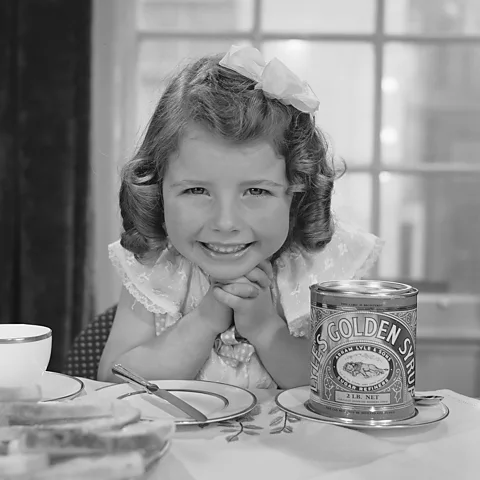By Sarah BregelFeatures correspondent

 Lyle’s Golden Syrup
Lyle’s Golden Syrup
Lyle’s Golden Syrup losing its biblical lion-carcass logo has caused an ‘unavoidable’ uproar.
Lyle’s Golden Syrup is undergoing a redesign. The British baking staple, now owned by Tate & Lyle Sugars, is highly recognisable because the logo has been unchanged for 140 years. The product is even the Guinness World Records holder for the world’s oldest logo.
Now, the company has redesigned the label on some of its products. The syrup that comes in a tin will retain the old label (the brand put out a social media post assuring dedicated consumers it wouldn’t be changing), while a new design has been released for other products, as well as the Lyle’s Golden Syrup that is sold in plastic bottles.
James Whiteley, brand director for Lyle’s Golden Syrup, told BBC News, “Our fresh, contemporary design brings Lyle’s into the modern day, appealing to the everyday British household while still feeling nostalgic and authentically Lyle’s.”
The old logo features a lion carcass surrounded by bees. According to the brand’s website, the company’s founder, the Scottish businessman Abram Lyle, wanted a logo that was inspired by a story in the Old Testament. It’s a nod to Samson, who kills a lion with his bare hands, but then discovers the bees have swarmed the dead lion. “Lyle had strong religious beliefs, which is why the tin’s famous logo depicts strongman Samson’s ‘lions and bees’ from the Bible’s Old Testament,” the brand explains on its website. “Out of the strong came forth sweetness,” the label reads.
The update won’t lose its central feature – the lion – though only its face appears, and instead of being surrounded by bees there is only one bee hovering over the lion’s head. It also retains its key colours, green and gold. Amrit Vin, a graphic designer and the editor of Brand New, a site dedicated to new and redesigned logos, says that important redesign considerations are solving issues with the old logo, and being “conceptually meaningful”. He feels the company managed to strike a balance between holding onto a “connection to the lion” while making it more “easily discernible”. He also says the new logo is easier to apply across all products.
While the change may seem overdue to some, altering the lion has caused an uproar online. Social media users, as well as news articles have critiqued the changes. “Why bother changing the squeezy bottle to blend in with the other homogeneous brands?” one Instagram user asked on the company’s page. “This feels like a waste of time and money.”
One X (formerly Twitter) user who said he was a descendent of Abram Lyle, explained the history of the logo in a post, and said he personally felt “the loss of Abram’s tin”. He told the Telegraph that the brand is “changing something that is both very distinctive and familiar to something generic and woolly”. The company also faced criticism from Church of England members who claimed the rebrand “eradicates” their Christian message. Tate & Lyle Sugars apologised for the upset caused and said religion played “no part” in the redesign.

 Getty
Getty
Whether to include religious imagery is an important consideration for a lot of modern brands. Baltimore-based art director Ashley Bacco says that “front and centre religious imagery will run the risk of alienating younger audiences” and “audiences of different religions backgrounds”. She says that brands should strive to be “inclusive to a broader market”.
That makes even more sense given that rates of those who identify with religious views seem to be falling. A 2020 YouGov survey found that 55% of Britons don’t subscribe to any set religion. Likewise, religion is less important to Americans than it was a decade ago. A 2021 Pew Research study found that only 3 in 10 US adults are religiously affiliated. And a 2023 study from Public Religion Research Institute (PRRI) found that 29% of Americans felt religion was unimportant to them, compared to 15% a decade earlier.
Making religious affiliations part of a brand’s advertising efforts can be tricky. In-N-Out Burger’s owners spoke publicly about why they print Bible verses on their packaging after customers realised the company had made a large political donation in 2018. Boycotts ensued, but the brand was able to hold on to the sentimental labelling. Forever21 came under fire for putting Bible verses on their shopping bags, too, but the backlash seemed connected to a combination of issues, including employee hours and benefits. The company filed for bankruptcy in 2019.
Regardless of a brand’s religious affiliation, Vin says the criticism is absolutely expected when updating a logo as old as Lyle’s. “The biggest thing to consider is that no matter how good or bad the new logo is, consumers will absolutely hate the change, so it’s really all about the conviction of the internal leadership team to know that the update is necessary and to stick with it no matter what the public reaction is.” Bacco seconds that. “When I redesigned the National Aquarium (in Baltimore) logo, there was considerable pushback because we had an audience that knew and loved the old logo and associated it with their childhood,” she says.
Vin understands that bidding farewell to a logo that’s over a century old is tough for consumers, even though most probably never even knew what the dead lion meant in the first place. That’s because, as Vin puts it, when it comes to redoing logos that are so old and recognizable, an “emotional connection with the consumer who has grown affectionate to the existing design” is a tough, yet practically “unavoidable” loss.
If you liked this story, sign up for The Essential List newsletter – a handpicked selection of features, videos and can’t-miss news delivered to your inbox every Friday.
If you would like to comment on this story or anything else you have seen on BBC Culture, head over to our Facebook page or message us on Twitter.





